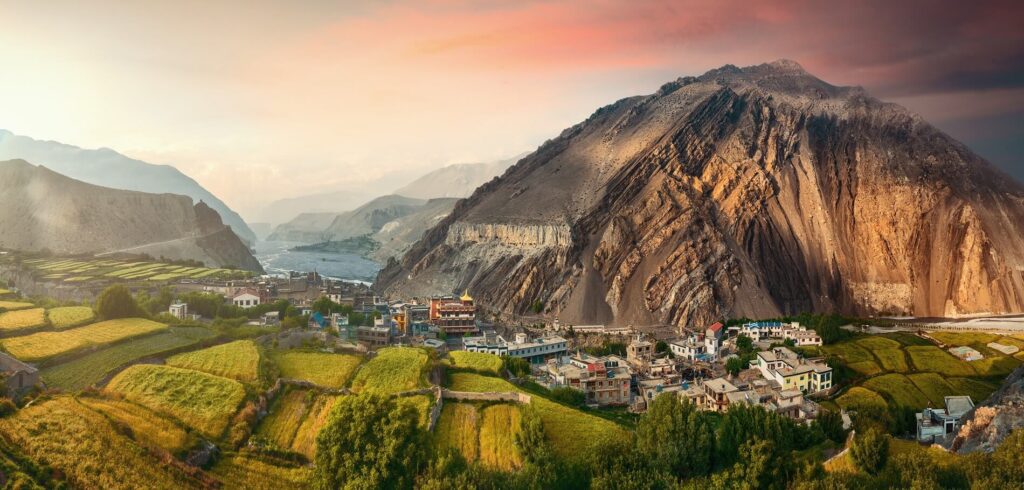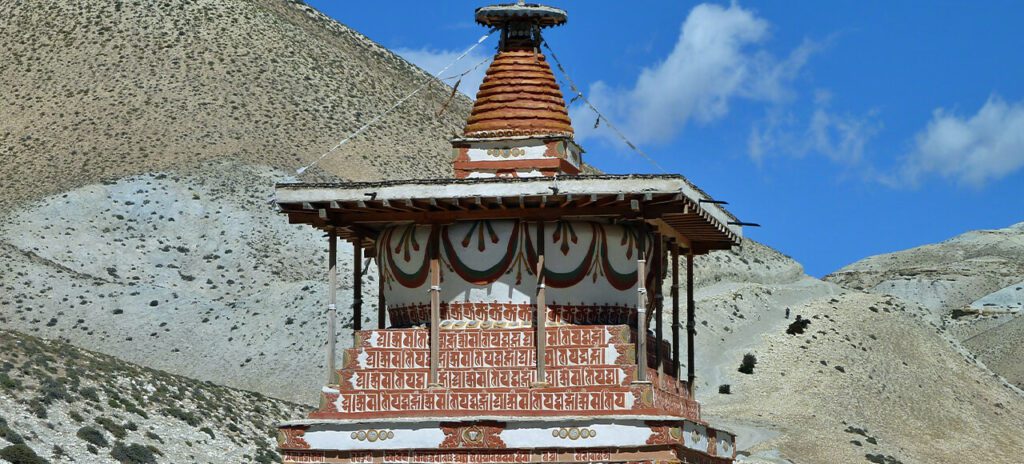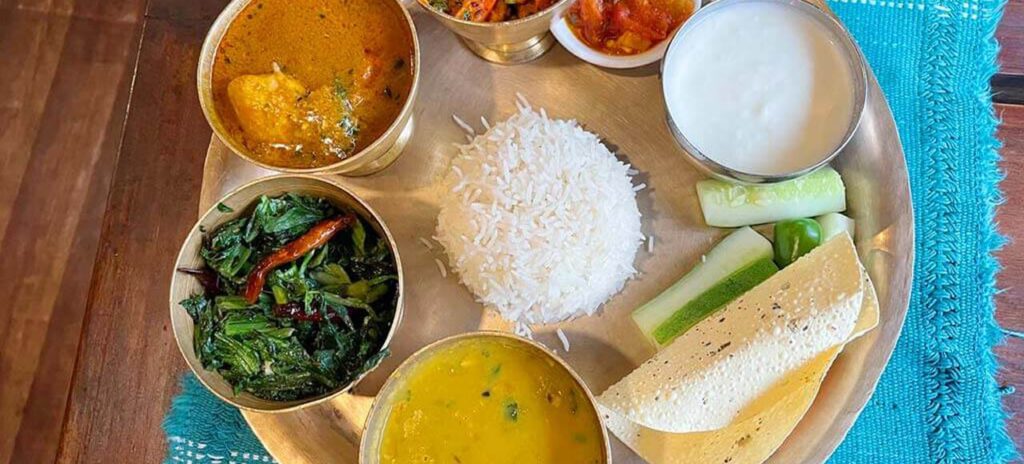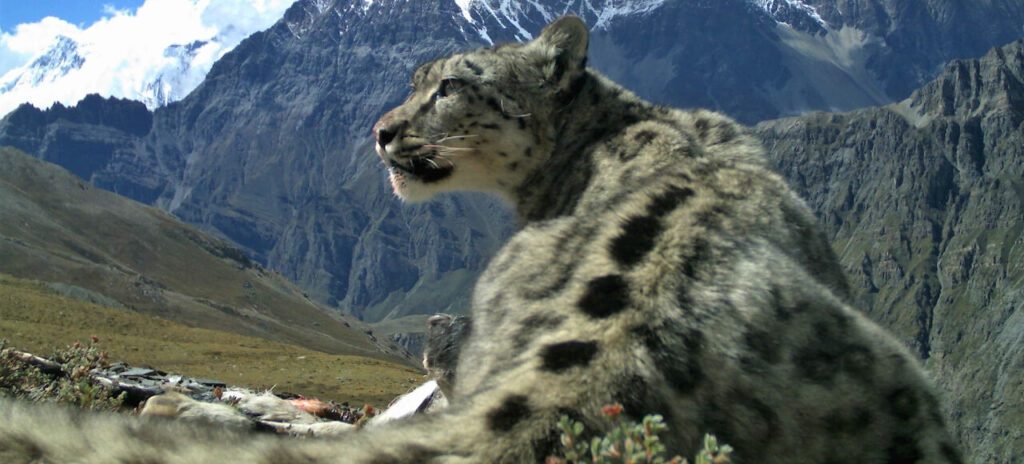If you’re looking for a thrilling adventure in Nepal, the Upper Mustang Trek in September is a perfect choice. September is the beginning of the peak trekking season in Nepal, with clear skies, moderate temperatures, and lush landscapes.

Upper Mustang, often called the “Forbidden Kingdom,” lies on Nepal’s remote northern border with Tibet. Upper Mustang offers history, culture, and natural beauty, an ideal destination for trekkers seeking a unique adventure.
Explore the ancient city of Lo Manthang, breathtaking mountain views, and embark on an unforgettable adventure in Upper Mustang.
Weather Conditions and Average Temperature
In September, Upper Mustang sees the tail end of the monsoon season. The first half may bring some rainfall, but the second half is generally clear and dry.
Temperatures in Upper Mustang during September vary from 10°C to 25°C, with an average daytime temperature of around 18°C.
Also Read: Upper Mustang Trek in August: Weather, Difficulty Travel Tips, and More
The temperature can drop to around 0°C at night, especially at higher altitudes. It’s important to note that Upper Mustang is a high-altitude region, with most of its terrain above 3,000 meters (9,800 feet) above sea level. Therefore, the weather can be unpredictable, and sudden changes in temperature and conditions can occur, especially in higher elevations.
Crowd
In September, the Upper Mustang trek is popular as monsoon ends, but it gets crowded, especially in places like Kagbeni.
You can expect to encounter many other trekkers, and lodges and teahouses can be busy. Some of the less popular routes may have fewer trekkers and be less crowded. For fewer crowds, consider trekking in the shoulder season, like October or November, when the weather remains favorable.
Highlights of the Upper Mustang Trek in September
In September, the Upper Mustang trek offers a fantastic journey through Mustang’s stunning landscapes and cultural highlights in Nepal. Here are some of the highlights of the trek in September:
Clear weather
September is the beginning of the autumn season in Nepal, and the weather is generally clear and dry. You can expect clear blue skies, pleasant daytime temperatures, and chilly nights. This makes for excellent trekking conditions with clear views of the Himalayan peaks.
Spectacular views of Himalayan peaks
The Upper Mustang trek offers stunning views of some of the highest peaks in the world including Annapurna, Dhaulagiri, Nilgiri, etc.

In September, the visibility is excellent, and you can see the snow-capped peaks clearly against the blue sky.
Unique cultural experience
The Upper Mustang region is known for its unique culture and traditions, which have been preserved for centuries.

During the trek, you will have the opportunity to visit ancient monasteries, caves, and other cultural landmarks that are unique to the region.
Natural wonders
The Upper Mustang region is home to many natural wonders, including the Kali Gandaki Gorge, the world’s deepest gorge, and the apple orchards of Marpha. You will also pass through arid desert-like landscapes and lush green valleys, each with its unique beauty.
Lower risk of rainfall
Unlike the monsoon season in Nepal which occurs between June and August, September is relatively dry with a lower risk of rainfall. This means that you can expect fewer muddy trails and easier trekking conditions, which makes for a more enjoyable and comfortable trek.
You may also like: Upper Mustang Trek in July: Travel Tips, Weather, and More
Authentic Nepali Cuisine
During the trek, you will have the opportunity to taste authentic Nepali cuisine, including the famous Dal Bhat, a lentil soup with rice and vegetables, and momos, a steamed dumpling filled with meat or vegetables.

The local cuisine is both delicious and nutritious, providing you with the energy needed to complete the trek.
Unique Accommodation
The Upper Mustang region is home to several traditional villages that have preserved their unique architectural style. The accommodation during the trek includes teahouses and lodges, which offer a glimpse into the local culture and way of life.
Upper Mustang from Kathmandu
There are several modes of transportation available to get to Upper Mustang from Kathmandu. However, due to the remote location and rugged terrain of the region, some modes of transportation may be limited or not available during certain times of the year. Here are some of the transportation options:
By Flight
To reach Upper Mustang from Kathmandu, you can book a connecting flight with domestic airlines in Nepal. Firstly, you can book a flight from Kathmandu to Pokhara, which takes around 25-30 minutes and provides mesmerizing views of the Himalayan range. Once you arrive in Pokhara, you can book another flight to Jomsom with the same airline or a different one like Tara Air or Nepal Airlines.
More: Upper Mustang Trek in June: Travel Tips, Weather, and More
The flight from Pokhara to Jomsom takes approximately 20–25 minutes and operates with small planes that fly over the Kali Gandaki River and the Annapurna and Dhaulagiri mountain ranges. After you arrive in Jomsom, you can hire a jeep or a local bus to reach Upper Mustang. The journey takes around 3-4 hours, depending on the road conditions and the weather.
Local Bus
You can take a local bus from Kathmandu to Pokhara, and then take another bus from Pokhara to Jomsom. From Jomsom, you can hire a jeep or a local bus to reach Upper Mustang. This is a cheaper option compared to hiring a private jeep, but the journey can be long and uncomfortable, especially if you have a lot of luggage.
Rented motorbike
If you’re an experienced rider and prefer a more adventurous mode of transportation, you can rent a motorbike in Kathmandu or Pokhara and ride to Upper Mustang. The journey can take around 10-12 hours, depending on your route and stops along the way. However, it’s important to note that the roads in the Upper Mustang region can be challenging and difficult to navigate, especially for inexperienced riders.
Private Jeep
For those seeking a more comfortable and flexible mode of transportation to Upper Mustang from Kathmandu, hiring a private jeep is a viable option. Private jeeps can be rented from either Kathmandu or Pokhara, and the cost will depend on the distance traveled and the number of passengers. Although more expensive than taking a bus or a local shared jeep, hiring a private jeep offers greater privacy and comfort.
By helicopter
Helicopter tours are becoming a popular alternative for travelers who prefer to avoid the lengthy and challenging overland journey to Upper Mustang. The duration of the flight is approximately 2-3 hours, depending on the weather conditions and specific itinerary. During the flight, you will witness breathtaking views of the Himalayan mountain range and the stunning landscapes of the Upper Mustang region.
Required Permits for Upper Mustang Trek
To trek in Upper Mustang, you’ll need a “Restricted Area Permit” from the Government of Nepal. It’s called restricted because it aims to protect the unique culture and environment of this region.
Getting the permit involves providing a copy of your passport, a passport-sized photograph, and paying the required fees. As of 2021, the permit costs USD 500 per person for the initial 10 days, with an extra USD 50 per day for each additional day.
Travel Tips, Weather, and More
In addition to the Restricted Area Permit, you also need to obtain the Annapurna Conservation Area Permit (ACAP), which costs USD 30 per person, and a TIMS (Trekkers’ Information Management System) card, which costs USD 20 per person. Both permits can be obtained from the Nepal Tourism Board in Kathmandu or Pokhara or from the entry checkpoint of the Annapurna Conservation Area.
Side Trek
Along with the main trail, there are several favorable side treks that trekkers can take to explore more of the region’s natural and cultural wonders.
Dhakmar and Ghiling Trek
This enchanting trail leads you through the quaint towns of Dhakmar and Ghiling, known for their unique red cliffs and rock formations that contrast beautifully with the surrounding landscape. The hike offers breathtaking vistas of the Mustang Himalayas making it a perfect option for those seeking to bask in the area’s natural beauty.
Muktinath trek
This side trek is a pilgrimage trek that leads to the sacred temple of Muktinath. The temple is a popular destination for both Hindus and Buddhists and is believed to offer spiritual purification to those who visit it. The trek passes through several traditional Tibetan villages and offers stunning views of the Mustang Himalayas. The Muktinath Trek is a unique cultural and spiritual experience that complements the main Upper Mustang trek.
Lo Gekar Monastery Trek
This side trek leads to the oldest monastery in Mustang, the Lo Gekar Monastery. The monastery consists of a unique cultural and historical landmark. The trek passes through several traditional Tibetan villages and offers beautiful views of the Mustang Himalayas. The Lo Gekar Monastery Trek is a great option for those who want to experience the rich history and culture of the region.
Saribung Peak Trek
This side trek is a challenging trek that leads to the summit of Saribung Peak which stands at an altitude of 6,328 meters. The trek offers stunning views of the Mustang Himalayas and is a great option for experienced trekkers who want to push their limits and test their skills. The Saribung Peak Trek is a unique adventure that complements the main Upper Mustang trek.
Read: Upper Mustang Trek in May: Weather, Difficulty Travel Tips, and More
Damodar Kunda Trek
This side trek is a pilgrimage trek that leads to the sacred Damodar Kunda Lake. The lake is believed to have been created by Lord Krishna and is a popular destination for both Hindus and Buddhists. The trek passes through several traditional Tibetan villages, offering stunning views of the Mustang Himalayas. Moreover, the Muktinath Trek provides a unique cultural and spiritual experience that complements the main Upper Mustang trek.
Trek to Kagbeni
The Kagbeni Trek is a popular side trek that can be done during the Upper Mustang Trek in Nepal. It starts from the town of Jomsom and passes through several traditional Tibetan villages before reaching the historic village of Kagbeni. This village once served as a checkpoint during the ancient salt trade route between Tibet and India. It is renowned for its traditional mud-brick houses and narrow alleyways. The trek offers a unique cultural and natural experience, along with stunning views of the Dhaulagiri and Nilgiri mountain ranges.
Flora and Fauna
The region is rich in flora and fauna, and trekking through it can provide a unique opportunity to experience some of the rarest species in the world.
Flora
The region is also renowned for its biodiversity, including a variety of plant life. Trekking through Upper Mustang in September is an excellent time to witness the blooming of many plants and flowers.
Here are some of the flora that can be seen during the Upper Mustang trek in September:
Wild rose
Wild roses are another species of plant that can be found in the Upper Mustang. Roses are known for their thorny branches and fragrant flowers, which can range in color from white to deep pink. In Upper Mustang, wild roses can be seen along the trekking trails in September. They typically bloom in the summer and fall, and visitors may see the last of their blooms in September.
Willow
Willow trees are also common in Upper Mustang, and their branches are often used for weaving baskets or other household items. The bark of the willow tree is used to make traditional medicine.
You may also like: Upper Mustang Trek in April: Weather, Difficulty Travel Tips, and More
Apple
Apple trees are common in Upper Mustang, and the region is known for its delicious apples. The apple trees bloom in the spring, and the fruit is ready to be harvested in September.
Juniper
Juniper trees are evergreen shrubs or small trees that can be found in Upper Mustang. They have a distinctive fragrance and are often used for incense.
Pine
Pine trees are evergreen trees that can be found throughout the Himalayas including in Upper Mustang. They have long needles and produce pine cones that can be used for firewood.
Himalayan Primrose
The Himalayan Primrose is a type of flowering plant that can be found in the alpine regions of Upper Mustang. These flowers have bright pink or white petals and are known for their fragrant scent.
Fauna
Upper Mustang is home to a diverse range of animal species, including mammals, birds, and insects. Furthermore, visitors to the region may have the opportunity to spot a variety of animals along the trekking trails in September.
Here are some of the animals that can be seen during the Upper Mustang trek in September:
Snow Leopard
The snow leopard is one of the most elusive animals in the world and is found in the mountains of Upper Mustang.

Although it is rare to spot a snow leopard, visitors may be able to see tracks or other signs of the animal.
Blue sheep
The blue sheep, also known as the Bharal, is a species of wild sheep found in the Himalayas. These animals can be seen grazing on the steep slopes of Upper Mustang and are known for their distinctive blue-gray coat.
Himalayan tahr
Found exclusively in the Himalayas, the Himalayan tahr is a large ungulate known for its shaggy fur and distinctive curved horns. Additionally, these creatures are celebrated for their impressive ability to navigate challenging terrain with ease.
Golden eagle
The Golden Eagle is a large bird of prey that can be found throughout the Himalayas. These birds are known for their powerful talons and beak and are often seen soaring overhead in search of prey.
Himalayan Griffon
In the highlands of Upper Mustang, the Himalayan Griffon vulture can be found. These birds play a crucial role in the ecosystem as scavengers helping to maintain cleanliness by consuming carrion and other organic waste.
Difficulty Level of Upper Mustang Trek in September
September is considered to be one of the best times to trek in the Upper Mustang as the weather is generally clear and dry. However, the difficulty level may still be challenging due to the high altitude and the long distance of the trek. The trek starts from Jomsom and goes up to Lo Manthang, which is situated at an altitude of 3,840 meters. Trekking at high altitudes can be challenging due to the low oxygen levels which may cause altitude sickness.
The trek also involves crossing several high passes, such as the Dhaulagiri Pass, which requires good physical fitness and endurance. The terrain can also be rugged and steep in some places which may require trekking poles and proper hiking boots.
Tips for the Upper Mustang Trek in September
The Upper Mustang trek in September can be an incredible experience, as the weather during this time is generally pleasant and clear.
Here are some tips that you may find useful for your Upper Mustang trek in September:
Plan your itinerary in advance
It is essential to plan your itinerary well in advance so that you can make the most of your trekking experience. You can choose to trek for around 10-14 days depending on your preference and make sure to include rest days in your itinerary.
Pack appropriate clothing
As the weather during September can be unpredictable, it is essential to pack appropriate clothing. You should bring warm layers, as the nights can get cold but also lightweight clothing for the daytime when the sun can be strong. It is also important to bring sturdy and comfortable trekking shoes as the terrain can be rugged.
Acclimatize properly
As Upper Mustang is located at a high altitude, it is crucial to acclimatize properly to avoid altitude sickness. It is recommended to spend a few days in the region before starting the trek to help your body adjust to the high altitude.
Stay hydrated
Staying hydrated is crucial in Upper Mustang due to high altitude and arid conditions, preventing dehydration is important. Make sure to carry enough water with you or bring water purification tablets to treat water from local streams.
Hire a local guide
Hiring a local guide is highly recommended as they can provide you with valuable insights into the local culture. They can also help you make arrangements for accommodation and food along the way.
Let our expert team at Asian Heritage Treks and Travel take care of everything — from guided tours to personalized packing tips and travel arrangements.
Plan My Mustang Trip







